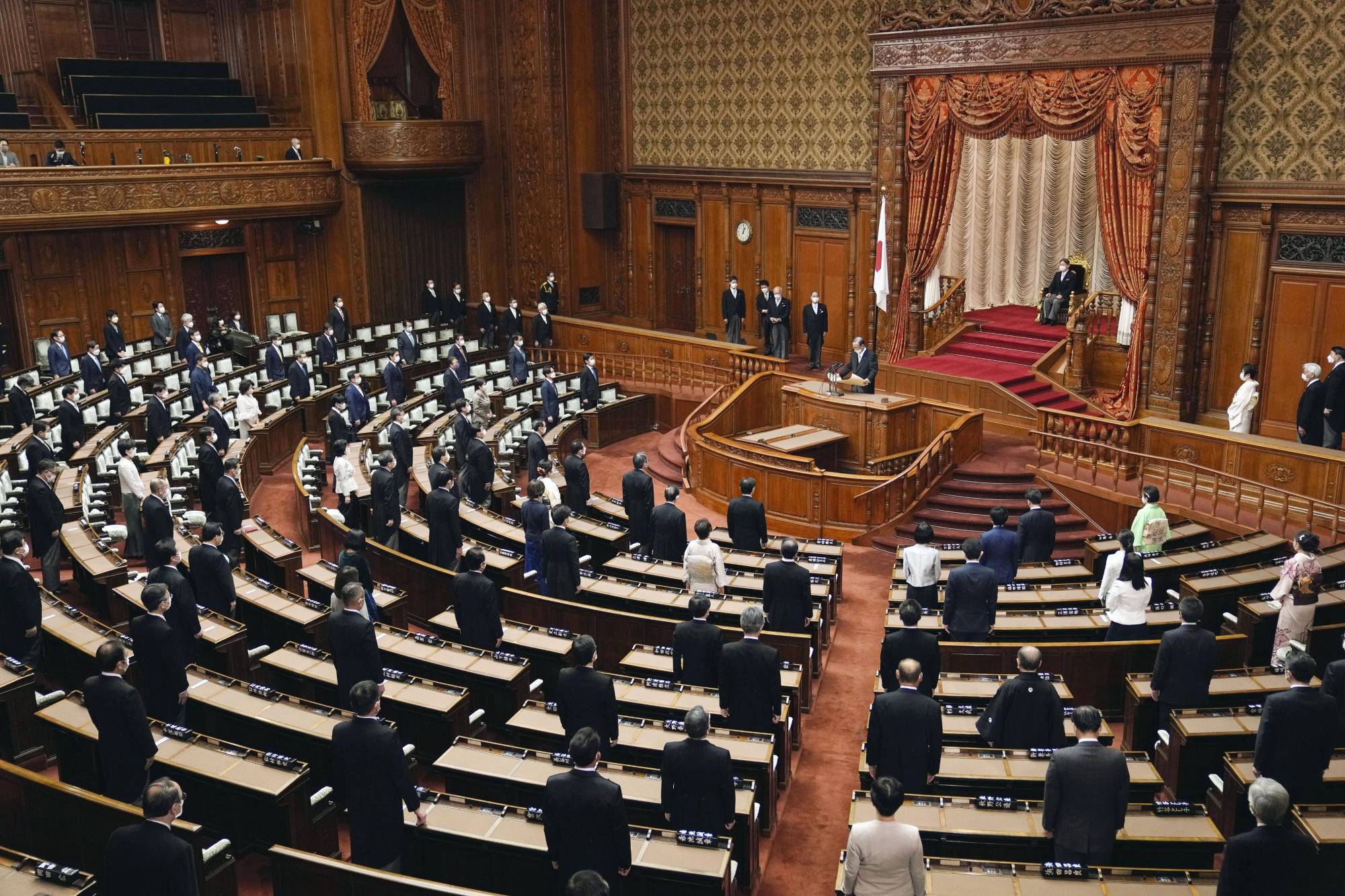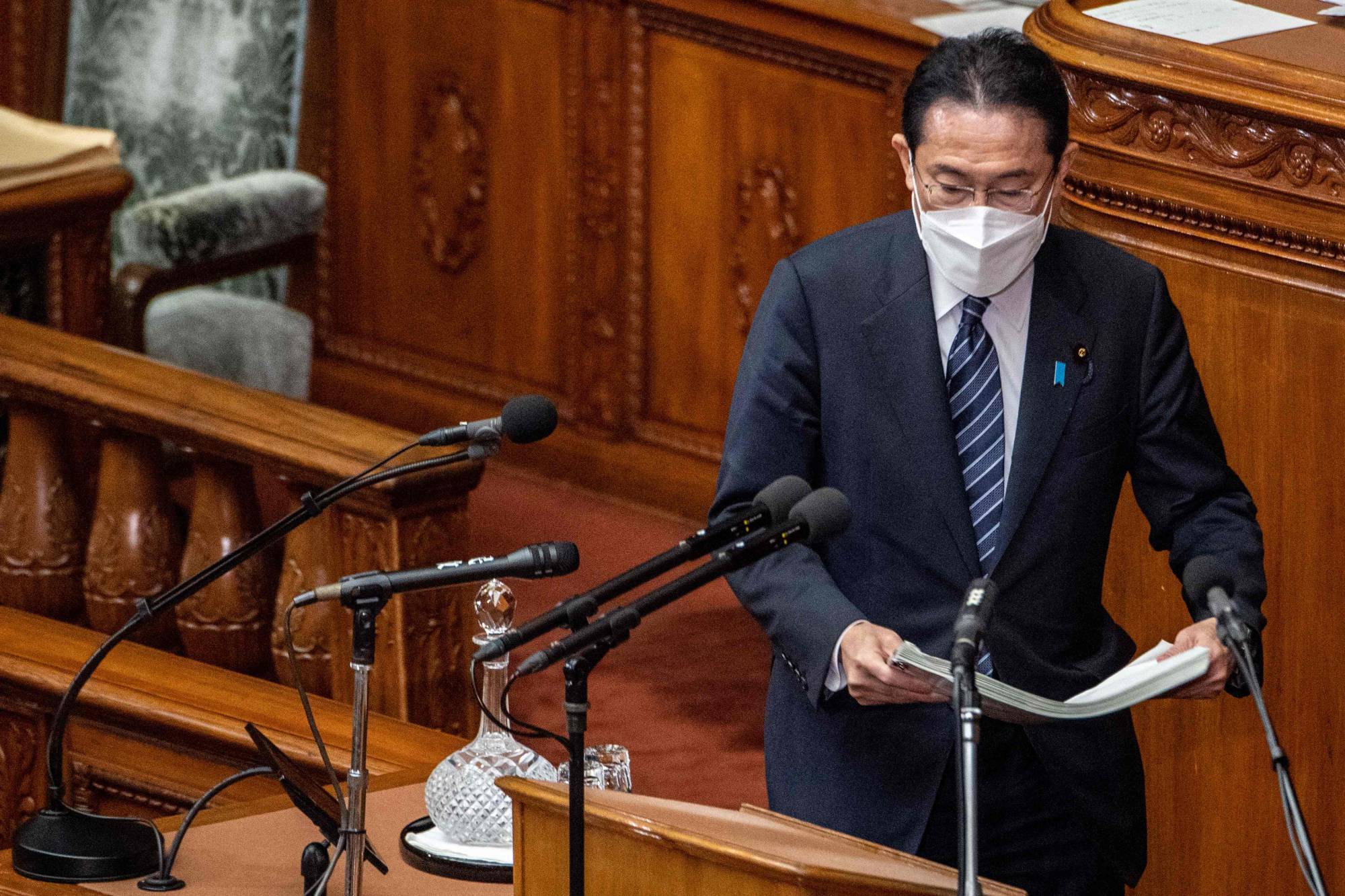Prime Minister Fumio Kishida kicked off a fresh parliamentary session on Monday with a policy speech, in which he vowed to come up with a road map in the spring for his long-term goal of shifting the nation toward a new form of capitalism that features a fairer distribution of wealth.
A large portion of the policy speech — Kishida’s third in the almost four months since he became prime minister — was devoted to Japan’s COVID-19 response, but overall it lacked new policies. That is partly because Kishida has been unveiling new ones as he goes, and it instead served more as a comprehensive wrap-up of what he has already announced.
The 150-day session will run until June 15, just before an Upper House election is likely to be held. Opposition parties have been preparing to pressure Kishida on virus measures, including pushing the government to be tougher on the U.S. military in Japan over its own COVID-19 measures.
“I am determined to take all the responsibility for each and every decision I make,” Kishida told the Lower House plenary session.
Unlike that of former Prime Minister Yoshihide Suga, Kishida’s support rate has been on the rise since COVID-19 cases started to inch up. In a Jiji poll released Friday, 51.7% of the respondents said they support the Kishida Cabinet, up from 44.9% in December, which the news agency has attributed to Kishida’s move to explain his virus policies to the public as much as he can.
COVID-19 measures
Amid the rising number of coronavirus cases, the majority of which are now of the omicron variant, Kishida said that virus measures are his top priority and that he will revise his policies in a flexible manner based on new findings.
“Even if it’s a policy we have decided, we will not hesitate to change them as we go if there is a better way,” Kishida said.
Kishida said entry restrictions, the strictest among the Group of Seven major economies, were meant to buy time so that Japan could prepare for a surge in cases — starting booster shots, increasing free testing, procuring oral treatments and making sure the health care system will not be overwhelmed.
To cope with a rise in the number of patients with mild symptoms or who are asymptomatic — but whose condition may nonetheless worsen — the government increased the number of local clinics and hospitals that will check up on or treat them at repurposed facilities or at home, raising the figure to 16,000 — up 30% from its original plan.
The prime minister also said he will reconsider the criteria for patients who need to be hospitalized and discharged, based on scientific findings and measures other countries are taking.
“From now on, we will put greater emphasis on domestic countermeasures,” he said.
The government has asked municipalities to administer booster shots sooner than initially planned — reducing the minimum interval after the second shot to six months for elderly people and seven months for the general public. Vaccination of children between the ages of 5 and 11 is expected to start as early as March.
Referring to COVID-19 cases at U.S. bases in Japan, especially in Okinawa Prefecture, Kishida said Japan will continue discussions on the matter through the Japan-U.S. Joint Committee.
New capitalism
On his vision for a new capitalism, something Kishida sees as being key to boosting the economy, the prime minister said he will draft a comprehensive plan and a road map in the spring.
Kishida warned that neoliberalism — an emphasis on light regulation and the free market — has led to wider disparities between the rich and the poor as well as urban and rural areas, causing society to become less stable.



To narrow down the income gap, one of Kishida’s priorities is to increase wages for workers.
“If we distribute the fruits of growth to workers, it will lead to increased wages — an investment in the future — and become a source of further growth,” said the prime minister. “I will create such a virtuous cycle.”
Touching on the annual labor-management wage negotiations held each spring, he voiced hope that companies will increase pay for their employees.
Digitalization, climate change, economic security and technology are areas that have both potential sources of growth and can help resolve problems in society, Kishida said.
Climate change
On climate change, Kishida reiterated Japan’s goal of achieving carbon neutrality by 2050 and reducing greenhouse gas emissions by 46% by fiscal 2030, which begins in April of that year, compared with fiscal 2013 levels.
“The negative aspects of capitalism are concentrated in the problems of climate change,” the prime minister said. “It is the biggest issue that needs to be overcome by realizing a new capitalism.”
At the same time, it is the biggest area for growth that the world is focused on, he said, with annual worldwide investment needing to reach an estimated $4 trillion (¥457.95 trillion) by 2030 in order to achieve 2050 carbon neutrality goals.



The prime minister said his government will offer direction on where the nation is heading on issues including carbon pricing, reducing carbon emissions in rural areas, renewable energy and shifts in people’s lifestyles stemming from efforts to reduce emissions.
Japan will also seek to create a group of nations in Asia aiming to achieve net-zero emissions, he said.
Diplomacy
Kishida, who served as foreign minister between 2012 to 2017, said he aims to create a “constructive and stable” relationship with China, with which Japan marks the 50th anniversary of normalized ties this year.
“We will say what needs to be said to China and strongly demand responsible acts,” said Kishida. “At the same time, we will have dialogue and cooperate on issues where we share concerns.”
Over the years, Japan has been highly concerned about China’s military buildup and its assertiveness in the South and East China seas, including areas surrounding the Japan-controlled Senkaku Islands, which Beijing also claims.
North Korea’s repeated ballistic missile launches can not be tolerated, Kishida said.
To cope with the change in the security situation, Kishida said that this year Japan will draft a new National Security Strategy, which outlines the country’s long-term plan in the field of diplomacy, a new National Defense Program Guidelines, which sets out the basic policy on the country’s defense, and a new Medium-Term Defense Program, which specifies development plans and necessary expenses over a five-year span.
While the alliance with the United States remains the main pillar of Japan’s diplomacy and security, Kishida also mentioned Australia as a partner with which it has been strengthening security cooperation.
In a time of both misinformation and too much information, quality journalism is more crucial than ever.
By subscribing, you can help us get the story right.
SUBSCRIBE NOW


